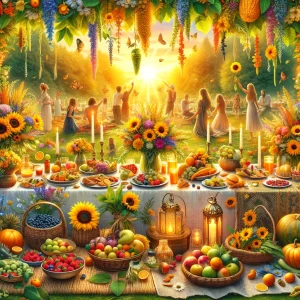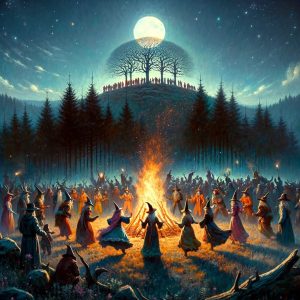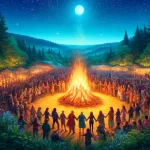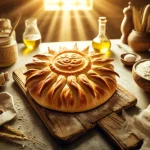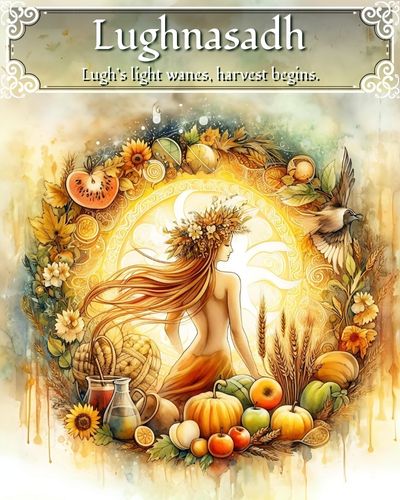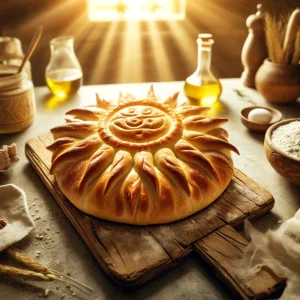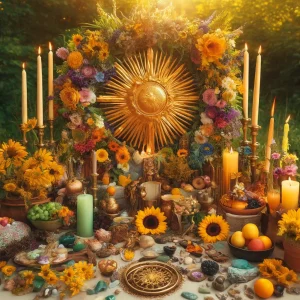
Approx. Reading time: About 8 Minutes

Introduction
The Summer Solstice: Celebrating the Height of Light
The summer solstice, also known as Midsummer or Litha, is a sacred and joyous time of the year when the sun reaches its highest point in the sky, resulting in the longest day and shortest night. This astronomical event holds deep significance in many cultures and spiritual traditions, symbolizing the peak of light, vitality, and abundance. In this article, we will explore the meaning of the term solstice, the origin of the word Litha, the history of the summer solstice, traditional customs, and rituals, as well as modern practices that honor this special time.

The Meaning of Solstice
The word “solstice” originates from the Latin words “sol” meaning “sun” and “sistere” meaning “to stand still.” It refers to the point in the Earth’s orbit around the sun when the sun reaches its highest or lowest point in the sky at noon, resulting in the longest or shortest day of the year. During the summer solstice, the sun appears to stand still for a moment before reversing its direction, marking the transition from longer days to shorter ones.
Midsummer, on the other hand, is a term used to describe the period around the summer solstice. It holds cultural and historical significance in many traditions and is celebrated as a time of abundance and fertility. Midsummer has been celebrated for centuries as a time of great power, when the forces of nature are at their peak. It is a time when the earth is alive with energy, and people rejoice in the beauty and vitality of the natural world.
The summer solstice and midsummer hold deep spiritual and symbolic meanings. They represent a time of illumination and growth, both externally and internally. The sun, at its zenith, symbolizes enlightenment, clarity, and the peak of life’s energy. It is a time to honor the power of the sun, to celebrate the abundance of nature, and to connect with the cycles of the Earth. Midsummer is seen as a time of transition, where we can reflect on our own inner light and the progress we have made on our personal journeys.
Whether you refer to it as the summer solstice or midsummer, this time of year is filled with significance and offers an opportunity for us to attune ourselves to the rhythms of nature, appreciate the beauty of the sun’s light, and connect with the vitality that surrounds us. It is a time to celebrate life, embrace the warmth of the sun, and find inspiration in the abundance of the natural world.
The Origin of the Word Litha
The word “Litha” is derived from Old English and is believed to have pagan origins. It specifically refers to the name given to the summer solstice celebration within the Wheel of the Year, a modern pagan tradition that honors the changing seasons. Litha has its roots in ancient Anglo-Saxon and Celtic cultures, where the solstice was seen as a significant moment of the year and marked the midpoint of summer.
The exact etymology of the word “Litha” is not entirely clear, as its origins have been lost to time. However, it is believed to have been influenced by Old Norse and Old English languages. In Old Norse, “Liða” meant “calm” or “gentle,” signifying the serene and warm nature of the summer season. In Old English, “litha” referred to the mild or gentle weather that characterized this time of year.
Litha, as a name for the summer solstice celebration, has been adopted by modern pagans and Wiccans to honor the midpoint of the year and the power of the sun during the longest day. It represents a time of abundance, growth, and vitality in nature. The word Litha evokes a sense of warmth, light, and the flourishing energy of the sun, encapsulating the essence of the summer solstice celebration.
As modern practitioners of earth-based spirituality and pagan traditions continue to celebrate the summer solstice, Litha serves as a term that embodies the ancient and mystical qualities of this significant celestial event. It is a word that holds the collective memories and meanings associated with the midsummer celebration, reminding us of the eternal connection between humanity and the natural world.
History of the Summer Solstice
The summer solstice has a rich history that spans cultures and civilizations throughout the ages. Known as Midsummer or Litha, this celestial event has been celebrated and revered by various societies across the globe. The solstice marks the longest day and shortest night of the year when the sun reaches its highest point in the sky and casts its rays directly over the Tropic of Cancer in the Northern Hemisphere.
Ancient Egypt and Rome
Ancient civilizations recognized the significance of the summer solstice and honored it with festivities and rituals. In ancient Egypt, the solstice coincided with the rising of the Nile River, which was crucial for agriculture and fertility. The Egyptians celebrated the solstice as a time of renewal and abundance, and it marked the beginning of the Egyptian New Year. Similarly, in ancient Rome, the festival of Vestalia was held during mid-June to honor the goddess Vesta, the protector of the hearth and home.
Celtic
In Celtic traditions, the summer solstice was called Midsummer, and it was a time of great celebration and reverence. The Celts believed that the power of the sun was at its peak during this time, and they celebrated with bonfires, feasting, and dancing. The solstice marked the transition from the waxing to the waning half of the year, symbolizing the turning of the wheel of the seasons and the cycle of life.
Litha, as a name for the summer solstice celebration, has its roots in ancient Anglo-Saxon and Celtic cultures. It is believed to have been a significant time for fertility rituals, as the energy of the sun was associated with abundance and growth in the natural world. The term Litha became popularized in modern pagan and Wiccan traditions, and it represents the celebration of the sun’s power and the abundance of nature during this pivotal moment of the year.
Throughout history, the summer solstice has been a time of honoring the sun, celebrating the bountiful harvests, and recognizing the cycles of life and nature. The customs and practices associated with the solstice may vary among different cultures and spiritual traditions, but the underlying theme of celebrating light, growth, and the warmth of the sun remains constant. Today, people from various backgrounds continue to gather at ancient sites, light bonfires, and partake in ceremonies to honor the summer solstice and its historical significance.
Traditional Customs and Rituals
Summer solstice and Litha are accompanied by a myriad of customs and rituals that have been observed for centuries. One of the most prominent traditions is the lighting of bonfires, which holds deep symbolism and significance. These bonfires represent the power and vitality of the sun and are believed to offer purification and protection. In ancient times, people would gather around the bonfires and participate in various rituals, such as leaping over the flames or driving their livestock through them. These acts were thought to bring fertility, prosperity, and ward off malevolent spirits.
Flowers and Herbs
Flowers and herbs also play a significant role in the summer solstice celebrations. Gathering and wearing these vibrant botanicals were common practices during this time. The vibrant colors and fragrant aromas of flowers symbolize the abundant energies of nature during the peak of summer. People would create floral wreaths and garlands to wear in their hair or decorate their homes and sacred spaces. Herbs, known for their healing properties and magical associations, were often collected, and used in rituals or hung in bundles to dry for future use.
Watching the Sun
Another traditional custom associated with the summer solstice is the practice of staying awake throughout the night, known as “watching the sun.” People would gather in sacred sites, such as stone circles or hilltops, to witness the sunrise and welcome the first rays of the new day. This act of vigilance and connection with nature was believed to bring blessings, spiritual insight, and a deep connection with the cycles of the Earth.
Water Rituals
Furthermore, water rituals have been observed during the summer solstice. This includes activities such as swimming in natural bodies of water, gathering dew from plants, or performing rituals near rivers and streams. Water, as a symbol of cleansing and rejuvenation, is an integral element in these practices. It is believed that by immersing oneself in water or collecting the dew, individuals can purify their spirits, promote healing, and attract abundance.
These customs and rituals associated with the summer solstice and Litha reflect the reverence and celebration of nature’s abundance, the power of the sun, and the vital energies of life. They provide a tangible connection to the cycles of the Earth and offer an opportunity for individuals to align themselves with the transformative energies of the season. Whether through bonfires, floral adornments, or engaging in water rituals, these traditional practices serve as a means of honoring the summer solstice and embracing the vibrant energies of nature.
Modern Practices
In modern times, the celebration of the summer solstice has evolved to incorporate a variety of practices that honor the significance of this celestial event. People from different backgrounds and spiritual beliefs engage in diverse activities to commemorate this special day and connect with the energy of the sun and nature.
Gatherings
Outdoor gatherings have become a popular way to celebrate the summer solstice. Friends, families, and communities come together in parks, gardens, or other natural settings to enjoy the warmth of the sun, share food and drinks, and engage in conversations and laughter. These gatherings often feature music and dance performances, creating a joyous and festive atmosphere that captures the spirit of the season.
Walks in Nature
Nature walks have also become a cherished activity during the summer solstice. Many individuals take the opportunity to explore the beauty of the natural world, whether it be through hiking in forests, strolling along the beach, or immersing themselves in the tranquil ambiance of a nearby park. This allows people to connect with the abundance of life and the rejuvenating energies of the season.
Meditation
Meditation practices have found their place in modern solstice celebrations as well. Many individuals choose to embrace the stillness and serenity of the summer solstice by finding a quiet space outdoors or in their homes. Through meditation, they seek to cultivate inner peace, reflect on personal growth, and align themselves with the transformative energies of the sun. This practice can bring about a sense of clarity, inspiration, and renewed purpose.
Nature Altars
Creating altars adorned with seasonal flowers and symbols of the sun is another modern practice that honors the summer solstice. These altars serve as a focal point for meditation, intention setting, and expressing gratitude. People may arrange flowers, light candles, and incorporate other meaningful objects that symbolize the vibrancy and power of the sun. It is a way to bring the energy of the solstice into their personal spaces and connect with the natural cycles.
Rituals during the summer solstice often reflect personal intentions and aspirations. Individuals may engage in rituals that involve setting goals and intentions for the remainder of the year or expressing gratitude for the blessings they have received thus far. These rituals provide an opportunity for self-reflection, personal growth, and a deeper connection with the cycles of nature.
In modern practices of the summer solstice, the emphasis is on embracing the warmth, light, and transformative energies of the sun. Whether through outdoor gatherings, nature walks, meditation, altar creations, or personal rituals, individuals have the freedom to celebrate the summer solstice in ways that resonate with their beliefs and intentions, while fostering a deeper connection with nature and the energies of the season.
Conclusion
The summer solstice and Litha are a time of vibrant energy and celebration, representing the height of light and the abundance of nature. As we gather to honor this significant moment in the annual cycle, we connect with the primal forces of the sun and the Earth, embracing the warmth and vitality that surrounds us. Whether through traditional customs or modern practices, the summer solstice invites us to appreciate the beauty of the natural world and to celebrate the power of light in our lives.

